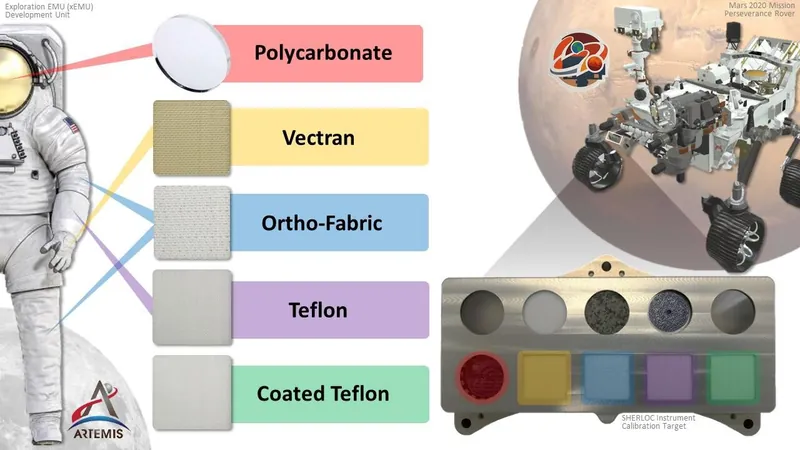
NASA's Perseverance Rover: Pioneering Spacesuit Technology for Future Mars Missions
2025-03-28
Author: Wei
NASA's Perseverance rover, which gracefully touched down on Mars in 2021, is not just on a quest to uncover ancient microbial life; it's also playing a crucial role in paving the path for human exploration of the Red Planet. Amidst its scientific pursuits, this remarkable rover carries five different samples of materials used in spacesuits, which have now endured four years of Mars' harsh environment. This phase of the mission focuses on studying these materials to predict the lifespan of Mars spacesuits accurately.
Why Spacesuit Longevity Matters
The core objective is clear: fill the gaps in our knowledge regarding how spacesuit materials react to Mars's unforgiving conditions. "We're preparing for people to explore Mars," states Marc Fries, a planetary scientist at NASA's Johnson Space Center in Houston and contributor to the spacesuit material initiative. Understanding how these materials perform under Martian conditions could revolutionize spacesuit design for future astronauts.
Among the five samples are essential materials like polycarbonate helmet visors, Vectran (a cut-resistant fabric used in astronaut gloves), and various forms of Teflon known for their dust-repellent properties. Also included is Ortho-Fabric, composed of multiple protective layers, including Nomex, Gore-Tex, and Kevlar, providing an effective barrier against fire, water, and puncture threats.
Facing Mars’s Brutal Conditions
Mars is notorious for its frigid temperatures, relentless dust, and a surface soaked in corrosive perchlorates, which can be lethal to humans. One of the biggest challenges for astronauts will be battling the solar radiation; without a magnetic field like Earth's, Mars offers minimal protection against harmful UV rays. Scientists are even investigating whether natural formations on Mars, such as caves, could provide astronauts with some much-needed shielding.
Regarding the spacesuit material samples, Joby Razzell Hollis, a member of the SHERLOC science team, notes that the destructive effects from solar radiation can significantly alter them—much like how white plastic chairs fade in the sun; in the Martian environment, this deterioration might accelerate due to higher UV exposure levels.
Innovating for the Future
Observations have shown that significant changes to the materials occurred within the first 200 days of the rover's deployment. The Vectran material exhibited signs of alteration early on, prompting researchers to delve deeper into understanding how different parts of spacesuits can withstand solar and environmental stressors.
To further the study, NASA's SHERLOC team is in the process of publishing a scientific paper detailing initial findings. Upcoming experiments will simulate Martian conditions in specially designed chambers, allowing researchers to measure the durability of spacesuit materials against the harsh Martian climate. "We want to see how the materials fare over time, as their weakening could lead to issues like heat and air leaks in spacesuits,” Fries explains.
Looking to the Stars
Perseverance’s primary mission extends beyond spacesuit development—it's focused on astrobiology and understanding Mars's geology, past climate, and long-term habitability for potential future human life. Additionally, it marks the first initiative to collect and cache samples of Martian rocks and regolith which NASA plans to retrieve in collaboration with the European Space Agency through the Mars Sample Return Program.
This exploration of Mars is part of a broader initiative by NASA to transition from the Moon to Mars, utilizing insights gained from the Artemis missions on the lunar surface to prepare for humanity's next giant leap into the cosmos. As Perseverance continues its quest on Mars, it's taking monumental steps not just for science, but for humanity's future among the stars.
Stay Tuned!
The next phase of research from NASA could unveil significant breakthroughs, making space exploration safer and more effective for future astronauts.




 Brasil (PT)
Brasil (PT)
 Canada (EN)
Canada (EN)
 Chile (ES)
Chile (ES)
 Česko (CS)
Česko (CS)
 대한민국 (KO)
대한민국 (KO)
 España (ES)
España (ES)
 France (FR)
France (FR)
 Hong Kong (EN)
Hong Kong (EN)
 Italia (IT)
Italia (IT)
 日本 (JA)
日本 (JA)
 Magyarország (HU)
Magyarország (HU)
 Norge (NO)
Norge (NO)
 Polska (PL)
Polska (PL)
 Schweiz (DE)
Schweiz (DE)
 Singapore (EN)
Singapore (EN)
 Sverige (SV)
Sverige (SV)
 Suomi (FI)
Suomi (FI)
 Türkiye (TR)
Türkiye (TR)
 الإمارات العربية المتحدة (AR)
الإمارات العربية المتحدة (AR)